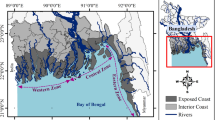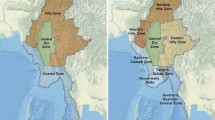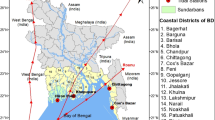Abstract
In the Northern Bay of Bengal (NBoB), cyclonic storms (wind speed: ≥34 knots) inflict considerable losses in coastal Bangladesh and India. By building a georeferenced panel database of storm landfalls for this region, one can obtain spatial information on period-wise strike intensities. In this study, 168 cyclone strike locations along a 1259-km impact zone were analyzed for seven historical periods between 1877 and 2016. Cyclone landfall trends for this region denote a gradual reduction in storm frequencies since peaking in 1961–1980, which is generally in line with already established trends for the Northern Indian Ocean and Bay of Bengal basins. One notable exception for the NBoB in this is the unimodal seasonality of storm landfalls during 1877–1960, but that also conformed to the bimodal regional trends in the later periods. Over time, the median location of storm strikes in the NBoB has shifted eastward into westernmost Bangladesh, with a particularly marked variability in location after 1960. Northern Odisha and West Bengal, India, experienced more cyclone strikes over the past 140 years; but the highest mean wind speeds occurred along Bangladesh’s eastern coast. Also, storm impacts have varied considerably within and across zones; northern Odisha and the Sundarban region of West Bengal have withstood the greatest impacts. The pronounced spatial and temporal variations in cyclone impacts evinced in this study can provide valuable information for relief prioritization and community adaptation to cyclones in the region. The general method developed for this analysis can be applied to other coastal locations for management of storm impacts.











Similar content being viewed by others
Change history
28 May 2021
A Correction to this paper has been published: https://doi.org/10.1007/s13143-021-00236-3
References
Ali, A.: Climate change impacts and adaptation assessment in Bangladesh. Climate Res. 12, 109–116 (1999)
Ali, A., Chowdhury, J.U.: Tropical cyclone risk assessment with special reference to Bangladesh. Mausam. 48(2), 305–322 (1997)
Asian Development Bank, Government of Odisha, World Bank (ADB-GoO-WB): Cyclone Phailin in Odisha October 2013: Rapid Damage and Needs Assessment Report, p. 60 (2013)
Bandyopadhyay, S.: Natural environmental hazards and their management: a case study of Sagar Island India. Singapore J. Tropical Geogr. 18, 20–45 (1997)
Bandyopadhyay, S., Dasgupta, S., Khan, Z.H., Wheeler, D.: Cyclonic Storm Landfalls in Bangladesh, West Bengal and Odisha, 1877–2016: a Spatiotemporal AnalysisPolicy Research Working Paper # 8316, World Bank Group, p. 25 (2018)
Barbier, E.: Valuing ecosystem services. In: McLeod, K., Leslie, H. (eds.) Ecosystem-Based Management for the Oceans, 2nd edn. Island Press, Washington, DC (2009)
Beck, M.W., Acosta-Morel, M., Narayan, S., Rittelmeyer, P.: Coastal protection services from coral reefs and mangroves in policy and practice: case studies. In: Beck, M.W., Lange, G.-M. (eds.) Managing Coasts with Natural Solutions: Guidelines for Measuring and Valuing the Coastal Protection Services of Mangroves and Coral Reefs, pp. 139–160. World Bank Group, Washington DC (2016)
Blankespoor, B., Dasgupta, S., Lange, G.-M.: Mangroves as a protection from storm surges in a changing climate. Ambio. 46(4), 478–491 (2017)
Brouwer, R.S., Akter, L., Brander, E., Haque, E.: Socioeconomic vulnerability and adaptation to environmental risk: a case study of climate change and flooding in Bangladesh. Risk. Ann. 27, 313–326 (2007)
BUET-BIDS (Bangladesh University of Engineering and Technology and Bangladesh Institute of Development Studies): Multipurpose Cyclone Shelter Programme. Planning and Implementation Issues. Part 4 Volume IVPrepared for Planning Commission, Government of Bangladesh and United Nations Development Programme / World Bank (1993)
Chaudhuri, S., Chattopadhyay, S.: Identification of coasts vulnerable for severe tropical cyclones — statistical elucidation. Mausam. 55(3), 502–506 (2004)
Coch, N.K.: Geologic effects of hurricanes. Geomorphology. 10, 37–63 (1994)
Costanza, R., Pérez-Maqueo, O., Martinez, M.L., Sutton, P., Anderson, S.J., Mulder, K.: The value of coastal wetlands for hurricane protection. Ambio. 37(4), 241–248 (2008)
Das, S., Das, A., Kar, N.S., Bandyopadhyay, S.: Cyclone Amphan and its impact on the lower deltaic West Bengal: a preliminary assessment using remote sensing sources. Curr. Sci. 119(8), 1246–1249 (2020)
Das, S., Vincent, J.R.: Mangroves protected villages and reduced death toll during Indian super cyclone. Proc. Natl. Acad. Sci. 18, 7357–7360 (2009)
Dasgupta, S., Hossain, M., Huq, M., Wheeler, D.: Facing the hungry tide: climate change livelihood threats and household responses in coastal Bangladesh. Clim. Change Econ. 7(3), (2016). https://doi.org/10.1142/S201000781650007X
Dasgupta, S., Huq, M., Khan, Z.H., Ahmed, M.M.Z., Mukherjee, N., Khan, M.F., Pandey, K.: Cyclones in a changing climate: the case of Bangladesh. Clim. Dev. 6(2), 96–110 (2014)
Dasgupta, S., Islam, M.S., Huq, M., Khan, Z.H., Hasib, M.R.: Mangroves as Protection from Storm Surges. World Bank Policy Research Working Paper # 8251World Bank Group, p. 31 (2017)
Dash, S.K., Kumar, J.R., Shekhar, M.S.: On the decreasing frequency of monsoon depressions over the Indian region. Curr. Sci. 86, 1404–1411 (2004)
Deo, A.A., Garner, W.: Tropical cyclone activity over the Indian Ocean in the warmer climate. In: Mohanty, U.C., Mohapatra, M., Singh, O.P., Bandyopadhyay, B.K., Rathore, L.S. (eds.) Monitoring and Prediction of Tropical Cyclones in the Indian Ocean and Climate Change, pp. 73–80. Springer, New York (2014)
EM-DAT (Emergency Events Database): The International Disaster Database. Center for Research on the Epidemiology of Disasters, Brussels. http://www.emdat.be/database (2019). Accessed 30 Aug 2019
GoB (Government of Bangladesh): Cyclone Sidr in Bangladesh: Damage, Loss, and Needs Assessment for Disaster Recovery and Reconstruction, p. 19 (2008)
GoWB (Government of West Bengal): Flood Management: Aila. Irrigation and Waterways Department, GoWB. https://wbiwd.gov.in/index.php/applications/aila (2009). Accessed 24 Jan 2019
Haque, A., Jahan, S.: Regional impact of cyclone Sidr in Bangladesh: a multi-sector analysis. Int. J. Disaster Risk Sci. 7, 312–327 (2016)
Haque, M.A., Haque, A., Ansari, M.A.: Water sanitation and health status of Aila affected coastal area of Bangladesh. J. Environ. Sci. 19, 51–56 (2010)
Hoque, M.A.-A., Phinn, S., Roelfsema, C., Childs, I.: Tropical cyclone disaster management using remote sensing and spatial analysis: a review. Int. J. Disaster Risk Reduction. 22, 345–354 (2017)
Hoque, M.A.-A., Phinn, S., Roelfsema, C., Childs, I.: Assessing tropical cyclone risks using geospatial techniques. Appl. Geogr. 98, 22–33 (2018)
Hossain, M.D.: Analysis of human vulnerability to cyclones and storm surges based on influencing physical and socioeconomic factors: evidences from coastal Bangladesh. Int. J. Disaster Risk Reduction. 13, 66–75 (2015)
HRC-NOAA (Hurricane Research Division, National Oceanic & Atmospheric Administration): Record Number of Storms by Basin Based on Data from 1981–2010. http://www.aoml.noaa.gov/hrd/tcfaq/E10.html (2018). Accessed 23 Jan 2019
IAA (International Aid Agencies): In-Depth Recovery Needs Assessment of Cyclone Aila Affected Areas, Bangladesh, p. 36 (2009)
IMD (India Meteorological Department): Severe Cyclonic Storm Aila: a Preliminary Report, p. 26. Regional Specialised Meteorological Centre-Tropical Cyclone, New Delhi. http://www.imd.gov.in/section/nhac/dynamic/aila.pdf (2010). Accessed 27 Oct 2013
IPCC (Intergovernmental Panel on Climate Change): Climate Change 2013: the Physical Science Basis, Contribution of Working Group I to the 5th Assessment Report, p. 1535. Cambridge University Press, Cambridge. http://www.ipcc.ch/site/assets/uploads/2018/02/WG1AR5_all_final.pdf (2013). Accessed 20 June 2019
IWM (Institute of Water Modelling): Hydraulic and Morphological Modelling Study to Aid Technical Feasibility Studies & Detailed Design for Coastal Embankment Improvement Project (CEIP). Final Report, Vol. I (2013)
IWM (Institute of Water Modelling): Coastal Embankment Improvement Project, Phase–I (CEIP-I): Technical Report on Survey, Storm Surge, Wave, Hydrodynamic Modelling and Design Parameters on Drainage System and Embankment Crest Level for Package-1, Package-2 and Package-3, Salinity and Morphological Study. Final Report (2018)
JPCO-IWM (Jaakko Pöyry Consulting Oy and Institute of Water Modelling): 2nd Coastal Embankment Rehabilitation Project, Stage-II. Hydraulic Modelling Study, Vol I and II, Polder Management Information System, Chittagong, Final Report (2003)
Kalsi, S.R.: Orissa super cyclone — a synopsis. Mausum. 57(1), 1–20 (2006)
Kar, N.S., Bandyopadhyay, S.: Tropical storm Aila in Gosaba block of Indian Sundarban: remote sensing based assessment of impact and recovery. Geogr. Rev. India. 77(1), 40–54 (2015)
Khalil, G.: Cyclones and storm surges in Bangladesh: some mitigative measures. Nat. Hazards. 6, 11–24 (1992)
Khalil, G.M.: The catastrophic cyclone of April 1991: its impact on the economy of Bangladesh. Nat. Hazards. 8, 263–281 (1993)
Khan, M.M.H., Bryceson, L., Kolivras, K.N., Faruque, F., Rahman, M.M., Haque, U.: Natural disasters and land-use/land-cover change in the southwest coastal areas of Bangladesh. Reg. Environ. Chang. 15, 241–250 (2015)
Krishna, K.M.: Intensifying tropical cyclones over the North Indian Ocean during summer monsoon – global warming. Global Planet. Change. 65, 12–16 (2009)
Krishnamohan, K.S., Mohanakumar, K., Joseph, P.V.: Climate change in tropical cyclones and monsoon depressions of North Indian Ocean. In: Mohanty, U.C., Mohapatra, M., Singh, O.P., Bandyopadhyay, B.K., Rathore, L.S. (eds.) Monitoring and Prediction of Tropical Cyclones in the Indian Ocean and Climate Change, pp. 33–39. Springer, New York (2014)
Kundu, S.N., Sahoo, A.K., Mohapatra, S., Singh, R.P.: Change analysis using IRS-P4 OCM data after the Orissa super cyclone. Int. J. Remote Sens. 22, 1383–1389 (2001)
Malleswararao, P., Jasmin, B.S.: Cyclone prone areas in the east coast of India. Mausum. 56(3), 686–689 (2005)
Mallick, B., Rahaman, K.R., Vogt, J.: Coastal livelihood and physical infrastructure in Bangladesh after cyclone Aila. Mitig. Adapt. Strat. Glob. Chang. 16, 629–648 (2011)
Mallick, B., Vogt, J.: Population displacement after cyclone and its consequences: empirical evidence from coastal Bangladesh. Nat. Hazards. 73, 191–212 (2013)
Mandke, S.K., Bhide, U.V.: A study of decreasing storm frequency over bay of Bengal. J. Indian Geophys. Union. 72, 53–58 (2003)
Martin, M., Kang, Y.H., Billah, M., Siddiqui, T., Black, R., Kniveton, D.: Climate-influenced migration in Bangladesh: the need for a policy realignment development. Pol. Rev. 35(52), O350–O379 (2017)
Mazumdar, J., Paul, S.K.: A spatially explicit method for identification of vulnerable hotspots of Odisha, India, from potential cyclones. Int. J. Disaster Risk Reduction. 27, 391–405 (2018)
Milton, D.: Some observations of global trends in tropical cyclone frequencies. Weather. 29(7), 242–277 (1974)
Mishra, A.: Temperature rise and trend of cyclones over the eastern coastal region of India. J. Earth Sci. Clim. Change. 5, 227 (2014)
Misra, S., Goswami, R., Mondal, T., Jana, R.: Social networks in the context of community response to disaster: study of a cyclone-affected community in coastal West Bengal. India. Int. J. Disaster Risk Reduction. 22, 281–296 (2017)
Mohapatra, M., Bandyopadhyay, B.K., Tyagi, A.: Best track parameters of tropical cyclones over the North Indian Ocean: a review. Nat. Hazards. 63, 1285–1317 (2012a)
Mohapatra, M., Bandyopadhyay, B.K., Tyagi, A.: Construction and quality of best tracks parameters for study of climate change impact on tropical cyclones over the North Indian Ocean during satellite era. In: Mohanty, U.C., Mohapatra, M., Singh, O.P., Bandyopadhyay, B.K., Rathore, L.S. (eds.) Monitoring and Prediction of Tropical Cyclones in the Indian Ocean and Climate Change, pp. 3–17. Springer, New York (2014)
Mohapatra, M., Mandal, G.S., Bandyopadhyay, B.K., Tyagi, A., Mohanty, U.C.: Classification of cyclone hazard prone districts of India. Nat. Hazards. 63, 1601–1620 (2012b)
Mohapatra, M., Srivastava, A.K., Balachandran, S., Geetha, B.: Inter-annual variation and trends in tropical cyclones and monsoon depressions over the North Indian Ocean. In: Rajeevan, M.N., Nayak, S. (eds.) Observed Climate Variability and Change over the Indian Region, pp. 89–106. Springer, Singapore (2017)
Mooley, D.A.: Severe cyclonic storms in the bay of Bengal 1877–1977. Am. Meteorol. Soc. Monthly Weather Rev. 108, 1647–1655 (1980)
Mooley, D.A.: Increase in annual frequency of the severe cyclonic storms of the bay of Bengal after 1964—possible causes. Mausam. 32(1), 35–40 (1981)
Mooley, D.A., Mohile, C.M.: A study of cyclonic storms incident in the different sections on the coast around Bay of Bengal. Mausam, 34(2), 139–152 (1983)
Mukherjee, S., Chaudhuri, A., Sen, S., Homechaudhuri, S.: Effect of cyclone Aila on estuarine fish assemblages in the Matla river of the Indian Sundarbans. J. Trop. Ecol. 28, 405–415 (2012)
Murakami, H., Sugi, M., Kitoh, A.: Future changes in tropical cyclone activity in the North Indian Ocean projected by high-resolution MRI-AGCMs. Climate Dynam. 40, 1949–1968 (2013)
Murakami, H., Sugi, M., Kitoh, A.: Future changes in tropical cyclone activity in the North Indian Ocean projected by the new high-resolution MRI-AGCM. In: Mohanty, U.C., Mohapatra, M., Singh, O.P., Bandyopadhyay, B.K., Rathore, L.S. (eds.) Monitoring and Prediction of Tropical Cyclones in the Indian Ocean and Climate Change, pp. 40–49. Springer, New York (2014)
Naqvi, N.S.: Periodicity of cyclonic storms and depressions in the northern Indian Ocean. In: Proceedings Inter-Regional Symposium on Tropical Cyclones, 18–31 January 1962, pp. 45–51. Japanese Meteorological Society, Tokyo (1963)
Narayan, S., Beck, M.W., Reguero, B.G., Losada, I.J., van Wesenbeeck, B., Pontee, N., Sanchirico, N.J., Ingram, J.C., Lange, G.-M., Burks-Copes, K.A.: The effectiveness, costs and coastal protection benefits of natural and nature-based defences. PLoS One. 11(5), e0154735, 17p (2016). https://doi.org/10.1371/journal.pone.0154735 Accessed 30 Aug 2019
National Institute of Disaster Management (NIDM): Proceedings, National Workshop on Phailin Cyclone 2013: Lessons Learnt, p. 60. Ministry of Home Affairs, Government of India. https://nidm.gov.in/pdf/pubs/proc%20phailin-14.pdf (2014). Accessed 31 Aug 2019
Ng, E.K.W., Chan, C.L.: Interannual variations of tropical cyclone activity over the North Indian Ocean. Int. J. Climatol. 32, 819–830 (2012)
Oochi, K., Yoshimura, J., Yoshimura, H., Mizuta, R., Kusunoki, S., Noda, A.: Tropical cyclone climatology in a global-warming climate as simulated in a 20 km-mesh global atmospheric model: frequency and wind intensity analyses. J Meteorological Soc. Japan. 84(2), 259–276 (2006)
Patwardhan, S.K., Bhamle, H.N.: A study of cyclonic disturbances over India and the adjacent ocean. Int. J. Climatol. 21, 527–534 (2001)
Raghabendra, V.K.: A statistical analysis of the number of tropical storm and depressions in the bay of Bengal during 1890–1969. Indian J. Meteorol. Geophys. 24, 125–130 (1973)
Rao, D.V.B., Naidu, C.V., Rao, B.R.S.: Trends and fluctuations of the cyclonic systems over North Indian Ocean. Mausam. 52(1), 37–46 (2001)
Sadhuram, Y., Maneesha, K.I., Ramana Murty, T.V.: Intensification of Aila (May 2009) due to a warm core eddy in the north Bay of Bengal. Nat. Hazards. 63(3), 1515–1525 (2011)
Sahoo, B., Bhaskaran, P.K.: Multi-hazard risk assessment of coastal vulnerability from tropical cyclones – a GIS based approach for the Odisha coast. J. Environ. Manage. 206, 1166–1178 (2018)
Shameem, M.I.M., Momtaz, S.: Vulnerability of rural livelihoods to multiple stressors: a case study from the southwest coastal region of Bangladesh. Ocean Coast. Manag. 102, 79–87 (2014)
Siddiqui, T., Islam, M.T., Kniveton, D., Black, R., Martin, M.: The staggering scale of climate-related migration and the need for pro-poor policies. Climate Change-Related Migration in Bangladesh: Briefing Paper No. 5, the Sussex Centre for Migration Research, University of Sussex & Refugee and Migratory Movements Research Unit, University of Dhaka (2013)
Singh, K., Panda, J., Rath, S.S.: Variability in landfalling trends of cyclonic disturbances over North Indian Ocean region during current and pre-warming climate. Theor. Appl. Climatol. 137, 417–439 (2018)
Singh, O.P.: Long term trends in the frequency of monsoonal cyclonic disturbances over the North Indian Ocean. Mausam. 52(4), 655–658 (2001)
Singh, O.P., Khan, T.M.A., Rahaman, M.S.: Has the frequency of intense tropical cyclones increased in the northern Indian Ocean? Curr. Sci. 80(4), 575–580 (2001)
Spalding, M., McIvor, A., Tonneijck, F.H., Tol, S., van Eijk, P.: Mangroves for Coastal Defence: Guidelines for Coastal Managers & Policy Makers. Wetlands International and the Nature Conservancy, p. 42 (2014) https://www.nature.org/media/oceansandcoasts/mangroves-for-coastal-defence.pdf. Accessed 30 Aug 2019
Srivastava, A.K., Ray, K.C.S., De, U.S.: Trends in frequency of cyclonic disturbances and their intensification over Indian seas. Mausam. 51(2), 113–118 (2000)
Subbaramayya, I., Rao, S.R.M.: Frequency of bay of Bengal cyclones in the post-monsoon season. Am. Meteorolog. Soc. Monthly Weather Rev. 112, 1640–1642 (1984)
Sugi, M., Murakami, H., Yoshimura, J.: Mechanism of the Indian Ocean tropical cyclone frequency changes due to global warming. In: Mohanty, U.C., Mohapatra, M., Singh, O.P., Bandyopadhyay, B.K., Rathore, L.S. (eds.) Monitoring and Prediction of Tropical Cyclones in the Indian Ocean and Climate Change, pp. 40–49. Springer, New York (2014)
Sultana, Z., Mallick, B.: Adaptation strategies after cyclone in southwest coastal Bangladesh—pro poor policy choices. Am. J. Rural Dev. 3, 24–33 (2015)
UNDP (United Nations Development Programme): Reducing Disaster Risk: a Challenge for Development, p. 146. UNDP Bureau for Crisis Prevention and Recovery, New York. https://www.undp.org/content/undp/en/home/librarypage/crisis-prevention-and-recovery/reducing-disaster-risk%2D%2Da-challenge-for-development.html (2004). Accessed 30 Aug 2019
UN-WB (United Nations and World Bank): Natural Hazards and Unnatural Disasters: the Economics of Effective Prevention. The World Bank Group, Washington, DC. https://www.gfdrr.org/sites/default/files/publication/natural-hazards-unnatural-disasters-2010.pdf (2010). Accessed 30 Aug 2019
Weinkle, J., Maue, R., Pielke Jr., R.: Historical global tropical cyclone landfalls. J. Climate. 25, 4729–4735 (2012)
WB (World Bank): Economics of Adaptation to Climate Change: Bangladesh, p. 102. The World Bank Group, Washington, DC. http://documents.worldbank.org/curated/en/841911468331803769/pdf/702660v10ESW0P0IC000EACC0Bangladesh.pdf (2010a). Accessed 30 Aug 2019
WB (World Bank): The Cost to Developing Countries of Adapting to Climate Change: New Methods and Estimates. http://siteresources.worldbank.org/EXTCC/Resources/EACC-june2010.pdf (2010b). Accessed 30 Aug 2019
WB (World Bank): The Cost of Adapting to Extreme Weather Events in a Changing Climate. Bangladesh Development Series Paper # 28, p. 41. World Bank Office, Dhaka. http://documents.worldbank.org/curated/en/716231468014361142/pdf/678450NWP0Box3000BDS28ClimateChange.pdf (2011). Accessed 30 Aug 2019
Yadav, D.K., Barve, A.: Analysis of socioeconomic vulnerability for cyclone-affected communities in coastal Odisha, India. Int. J. Disaster Risk Reduction. 22, 387–396 (2017)
Acknowledgments
This research was conducted under the South Asia Water Initiative – Sundarbans Targeted Environmental Studies. We thank Sushil Gupta, Anup Karanth, and Tapas Paul for their help in procuring the data. Thanks also go to Karabi Das and Nabendu Sekhar Kar for their help with data processing.
The results, analyses, and conclusions presented in this article are entirely those of the authors. They do not necessarily stand for the views of the International Bank for Reconstruction and Development / World Bank and its affiliated organizations, or those of the Executive Directors of the World Bank or the governments represented by them.
Author information
Authors and Affiliations
Corresponding author
Additional information
Responsible Editor: Edvin Aldrian.
Publisher’s Note
Springer Nature remains neutral with regard to jurisdictional claims in published maps and institutional affiliations.
The original online version of this article was revised: Due to an unfortunate oversight during the correction process the images have not been updated.
Rights and permissions
About this article
Cite this article
Bandyopadhyay, S., Dasgupta, S., Khan, Z.H. et al. Spatiotemporal Analysis of Tropical Cyclone Landfalls in Northern Bay of Bengal, India and Bangladesh. Asia-Pacific J Atmos Sci 57, 799–815 (2021). https://doi.org/10.1007/s13143-021-00227-4
Received:
Revised:
Accepted:
Published:
Issue Date:
DOI: https://doi.org/10.1007/s13143-021-00227-4




